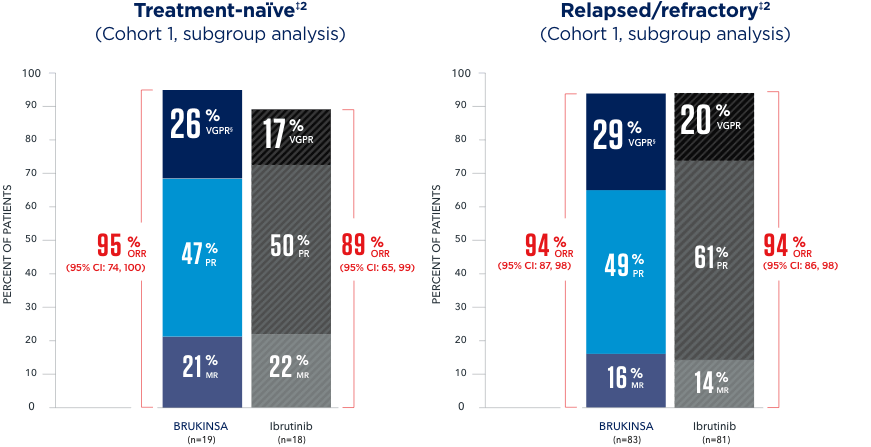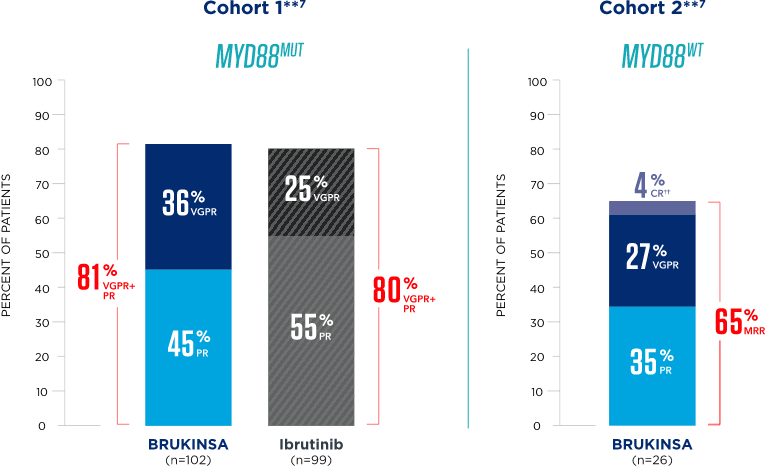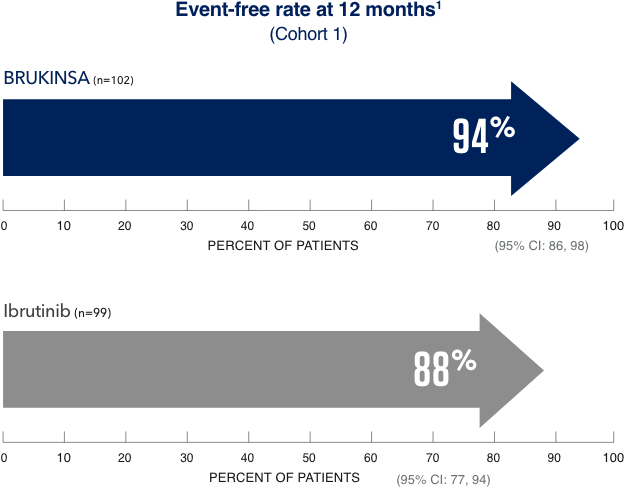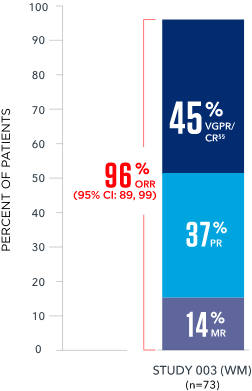BRUKINSA patients can call the myBeOne Support™ program to talk to a dedicated nurse: 1-833-234-4363
POWERFUL AND DURABLE RESPONSES
Adults with WM rapidly achieved high response rates regardless of line of therapy or mutation.

In all patients, median time to response (CR+VGPR+PR) was 2.8 months for the BRUKINSA arm and 2.9 months for the ibrutinib arm.3
The median follow-up time was 19.4 months.2
The prespecified efficacy outcome measure of VGPR/CR was assessed by IRC.1
*IWWM-6 criteria (Owen et al, 2013) requires complete resolution of extramedullary disease (EMD) if present at baseline for VGPR to be assessed. Modified IWWM-6 criteria (Treon, 2015) requires a reduction in EMD if present at baseline for VGPR to be assessed.4,5
†There were no CRs in either treatment arm.
CI=confidence interval; CR=complete response; IRC=independent review committee; IWWM-6=6th International Workshop on Waldenström’s Macroglobulinemia; PR=partial response; VGPR=very good partial response; WM=Waldenström’s macroglobulinemia.
Initial analysis (19 months)2

All subgroup analyses are exploratory and descriptive in nature.
The median follow-up time was 19.4 months.2
‡Responses were determined using modified IWWM-6 criteria.
§There were no CRs in either treatment arm.
CI=confidence interval; CR=complete response; IWWM-6=6th International Workshop on Waldenström’s Macroglobulinemia; MR=minor response; ORR=overall response rate; PR=partial response; VGPR=very good partial response.
Initial analysis (19 and 18 months, respectively)2,6

All analyses are exploratory and descriptive in nature.
The median follow-up time was 19.4 months for Cohort 1 and 17.9 months for Cohort 2.2,6
¶Responses were determined using modified IWWM-6 criteria.
#There were no CRs in either treatment arm.
CR=complete response; IWWM-6=6th International Workshop on Waldenström’s Macroglobulinemia; MUT=mutated; PR=partial response; VGPR=very good partial response; WHIM=WHIM syndrome-like somatic mutation; WT=wild type.
Long-term analysis (44 months and 43 months, respectively)7

All analyses are exploratory and descriptive in nature.
The median follow-up time was 44.4 months for Cohort 1 and 42.9 months for Cohort 2.7
**Responses were determined using modified IWWM-6 criteria.
††In Cohort 2, 1 patient demonstrated a CR at 42.9-month follow-up.
CR=complete response; IWWM-6=6th International Workshop on Waldenström’s Macroglobulinemia; MRR=major response rate; MUT=mutated; PR=partial response; VGPR=very good partial response; WT=wild type.
WITH BRUKINSA
Sustained responses in patients who achieved a response (CR+VGPR+PR)
Initial analysis (19 months)2

All subgroup analyses are exploratory and descriptive in nature.
Median duration of response (VGPR/CR) was not reached in either treatment arm.2
The median follow-up time was 19.4 months.2
At 2 years: Event-free duration of CR+VGPR for BRUKINSA was higher (90.6%; range 73.6%, 96.9%) vs ibrutinib (79.3%; range 53.5%, 91.8%)7
CI=confidence interval; CR=complete response; PR=partial response; VGPR=very good partial response.
A Phase 1/2, open-label, multicenter, single-arm trial including 77 patients with treatment-naïve and relapsed/refractory WM‡‡

Data are consistent with results observed in ASPEN (Study 302) and the overall safety profile of BRUKINSA.8
Median follow-up time was 24 months in patients with treatment-naïve WM and 36 months in patients with R/R WM.8
‡‡Assessed by IRC using modified IWWM-6 criteria.
§§There was 1 CR in the study.
CI=confidence interval; CR=complete response; IRC=independent review committee; IWWM-6=6th International Workshop on Waldenström’s Macroglobulinemia; MR=minor response; ORR=overall response rate; PR=partial response; R/R=relapsed/refractory; VGPR=very good partial response; WM=Waldenström’s macroglobulinemia.
IMPORTANT SAFETY INFORMATION
What should I tell my healthcare provider before taking BRUKINSA?
Before taking BRUKINSA, tell your healthcare provider about all of your medical conditions, including if you:
- have bleeding problems.
- have had recent surgery or plan to have surgery. Your healthcare provider may stop BRUKINSA for any planned medical, surgical, or dental procedure.
- have an infection.
- have or had heart rhythm problems.
- have high blood pressure.
- have liver problems, including a history of hepatitis B virus (HBV) infection.
- are pregnant or plan to become pregnant. BRUKINSA can harm your unborn baby. If you are able to become pregnant, your healthcare provider may do a pregnancy test before starting treatment with BRUKINSA.
- Females should avoid getting pregnant during treatment and for 1 week after the last dose of BRUKINSA. You should use effective birth control (contraception) during treatment and for 1 week after the last dose of BRUKINSA.
- Males should avoid getting female partners pregnant during treatment and for 1 week after the last dose of BRUKINSA. You should use effective birth control (contraception) during treatment and for 1 week after the last dose of BRUKINSA.
- are breastfeeding or plan to breastfeed. It is not known if BRUKINSA passes into your breast milk. Do not breastfeed during treatment with BRUKINSA and for 2 weeks after the last dose of BRUKINSA.
Tell your healthcare provider about all the medicines you take, including prescription and over-the-counter medicines, vitamins, and herbal supplements. Taking BRUKINSA with certain other medications may affect how BRUKINSA works and can cause side effects.
What are the possible side effects of BRUKINSA?
BRUKINSA may cause serious side effects, including:
- Bleeding problems (hemorrhage). Bleeding problems are common with BRUKINSA, and can be serious and may lead to death. Your risk of bleeding may increase if you are also taking a blood thinner medicine. Tell your healthcare provider if you have any signs or symptoms of bleeding, including:
- blood in your stools or black stools (looks like tar)
- pink or brown urine
- unexpected bleeding, or bleeding that is severe or you cannot control
- vomit blood or vomit that looks like coffee grounds
- cough up blood or blood clots
- increased bruising
- dizziness
- weakness
- confusion
- change in speech
- headache that lasts a long time
- Infections that can be serious and may lead to death. Tell your healthcare provider right away if you have fever, chills, or flu-like symptoms.
- Decrease in blood cell counts (white blood cells, platelets, and red blood cells). Your healthcare provider should do blood tests during treatment with BRUKINSA to check your blood counts.
- Second primary cancers. New cancers have happened in people during treatment with BRUKINSA, including cancers of the skin or other organs. Your healthcare provider will check you for other cancers during treatment with BRUKINSA. Use sun protection when you are outside in sunlight.
- Heart rhythm problems (atrial fibrillation, atrial flutter, and ventricular arrhythmias) that can be serious and may lead to death. Tell your healthcare provider if you have any of the following signs or symptoms:
- your heartbeat is fast or irregular
- feel lightheaded or dizzy
- pass out (faint)
- shortness of breath
- chest discomfort
- Liver problems. Liver problems, which may be severe or life-threatening, or lead to death, can happen in people treated with BRUKINSA. Your healthcare provider will do blood tests to check your liver before and during treatment with BRUKINSA. Tell your healthcare provider or get medical help right away if you have any signs of liver problems, including stomach pain or discomfort, dark-colored urine, or yellow skin and eyes.
The most common side effects of BRUKINSA include:
- decreased white blood cell count
- decreased platelet count
- upper respiratory tract infection
- bleeding
- muscle, bone, or joint pain
These are not all the possible side effects of BRUKINSA. Call your doctor for medical advice about side effects. You may report side effects to FDA at 1-800-FDA-1088.
What is BRUKINSA?
BRUKINSA is a prescription medicine used to treat adults with:
- Chronic lymphocytic leukemia (CLL) or small lymphocytic lymphoma (SLL).
- Waldenström’s macroglobulinemia (WM).
- Mantle cell lymphoma (MCL) who have received at least one prior treatment for their cancer.
- Marginal zone lymphoma (MZL) when the disease has come back or did not respond to treatment and who have received at least one certain type of treatment.
- Follicular lymphoma (FL), in combination with the medicine obinutuzumab, when the disease has come back or did not respond to treatment and who have received at least two prior treatments.
It is not known if BRUKINSA is safe and effective in children.
Please see full Prescribing Information including Patient Information.

